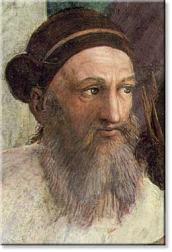
- Zoroaster -
Zoroastrianism is uniquely important in the history of religion because of its possible formative links to both Western Abrahamic and Eastern Dharmic religious traditions. Mazdaism is the name of the religion that acknowledges the divine authority of Ahura Mazda, proclaimed by Zoroaster to be the one uncreated Creator of all (God).
Zoroastrianism
is the name of the religion and philosophy based on the teachings ascribed to the prophet
Zoroaster
(Zarathushtra, Zartosht, Sarastro). The primary collection of sacred texts of Zoroastrianism are the
Avesta.
Zurman is the primordial god in Persian religion, Zurvan is the father of the
good god Ahura Mazda and the evil god Angra Mainyu. In
Zurvanism, the state religion of the Sassanides in the
3rd-7th century CE, Zurvan is the highest god and lord of the four elements and the god of infinite time and space.
Ahura Mazda/Ohrmuzd (together with, or represented by, Spenta Mainyu) is the guardian of humankind.
Spenta Mainyu
("holy spirit") is the god of life and the personification of the good and the light.
He is the twin brother of Angra Mainyu
(Ahriman), the god of darkness, with whom he fights an eternal battle.
Angra Mainyu (Avestan) or Ahriman is the Evil equivalent of the deity Ahura Mazda. Angra Mainyu is the god of
darkness, the eternal destroyer of good, personification and creator of evil,
bringer of death and disease. He is also known as Ahriman, and his name means "fiendish spirit".
Zoroastrianism recognizes various classes of spiritual beings besides the Supreme Being
(Ahura Mazda): The Amesha Spentas,
Yazatas, and
Fravashis.
Amesha Spenta is an Avestan language term for a class
of divinity/divine concepts in Zoroastrianism, and literally means "Bounteous Immortal".
The six Amesha Spenta
(Phl. Amahraspandan) or primeval creations brought together in
Yasna 47.1 of the
Gathas are as follows:
Zoroastrianism was influenced in part by other religions and influenced other religions. The idea of Satan, the idea of angels and demons, the final resurrection and final judgement were found already in Zoroastrianism. However there is no consensus on the influence that Zoroastrianism has had on the three Abrahamic religions. Today Zorastriansims continues mainly among the Parsi or Parsee and the Irani.

 Zarathushtra
Zarathushtra
 Gathas
Gathas
 Gathas
Gathas
 Yasna
Yasna
 Zoroastrian Archives - Avesta
Zoroastrian Archives - Avesta
 Avesta
Avesta
 Khorda Avesta
Khorda Avesta
 Amesha Spenta
Amesha Spenta
 Zoroastrian angelology
Zoroastrian angelology
 Angel in Zoroastrian Religion
Angel in Zoroastrian Religion
 The Zarathushtrian Assembly
The Zarathushtrian Assembly
 World of Traditional Zoroastrianism
World of Traditional Zoroastrianism
 The Chaldaean Oracles of Zoroaster - Expositions of Pletho and Psellus
The Chaldaean Oracles of Zoroaster - Expositions of Pletho and Psellus
 Funeral ceremonies
Funeral ceremonies
 Tower of Silence
Tower of Silence
 Parsi
Parsi
Dharmic religions are a family of religions whose theology and philosophy center on the concept of Dharma, a Sanskrit term for "fixed decree, law, duty", especially in a spiritual sense of "natural law, reality". All Dharmic religions were born in India. It is mostly influential across the Indian subcontinent, East Asia and South East Asia with influence felt throughout the world. These Dharmic religions are very closely interrelated. In Hinduism, dharma signifies behaviors that are considered to be in accord with rta, the order that makes life and universe possible, and includes duties, rights, laws, conduct, virtues and "right way of living". In Buddhism dharma means "cosmic law and order", but is also applied to the teachings of the Buddha. In Buddhist philosophy, dharma is also the term for "phenomena". In Jainism dharma refers to the teachings of the Jinas and the body of doctrine pertaining to the purification and moral transformation of human beings. For Sikhism, the word dharm means the "path of righteousness" (see also Indian Religions: A Historical Reader of Spiritual Expression and Experience, P. Heehs, New York University Press, 2002).
The main Dharmic religions are: Hinduism, Buddhism, Sikhism and Jainism
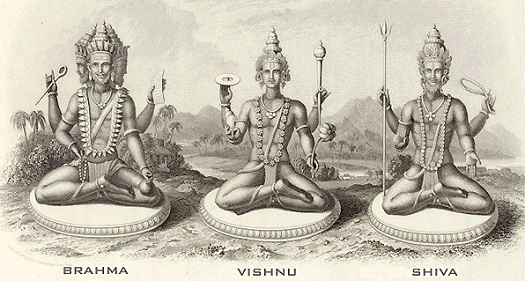
Astika includes the four major Hindu groups: Shaivism, Shaktism, Vaishnavism, Smartism.
The "Trimūrti" ("three forms") is a concept in Hinduismin which the cosmic functions of creation, maintenance, and destruction are personified by the forms of Brahma the creator, Vishnu the maintainer or preserver and Shiva the destroyer or transformer. These three gods have been called "the Hindu triad" or the "Great Trinity", often addressed as "Brahma-Vishnu-Maheshwara" (see also An Introduction to Hinduism, Gavin D. Flood, Cambridge University Press, 1996 and Unifying Hinduism: Philosophy and Identity in Indian Intellectual History, Andrew J. Nicholson, Columbia University Press, 2013).
Nastika refers to all traditions that reject and deny the scriptural authority of the Vedas. This in general includes Sikhism, Jainism, Buddhism, the Chārvāka (Lokāyata) materialists and others (see also The Blackwell Companion to Hinduism, Gavin Flood, John Wiley & Sons, 2008).
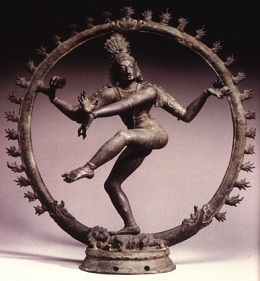
There are six Darshanas (viewpoints) of the Astik religion: Vedanta, Samkhya, Nyaya, Yoga, Purva Mimamsa, Vaisheshika. Sāmkhya is an atheistic and strongly dualist theoretical exposition of consciousness and matter. Rāja yoga is a school emphasising meditation, contemplation and liberation. Nyāya or logic, explores sources of knowledge written down in the Nyāya Sūtras. Vaisheshika is an empiricist school of atomism. Mimāṃsā is an anti-ascetic and anti-mysticist school of orthopraxy. Vedanta, the last segment of knowledge in the Vedas, or the 'Jnan' (knowledge) 'Kanda' (section). Vedanta came to be the dominant current of Hinduism in the post-medieval period.
Sāmkhya is an enumerationist philosophy that is strongly dualist (an enumeration is a collection of items that is a complete, ordered listing of all of the items in that collection). Sāmkhya philosophy regards the universe as consisting of two realities; Puruṣa (consciousness) and prakṛiti (phenomenal realm of matter). Puruṣa means the cosmic man or it means Self, Consciousness, and Universal principle. Prakṛiti is the essential constituent of the universe and is at the basis of all the activity of the creation. Sāmkhya sees the universe as an evolving mixture of distinct dualities (light/dark, male/female, etc). Jiva is that state in which puruṣa is bonded to prakriti through the glue of desire, and the end of this bondage is moksha. Moksha means emancipation, liberation or release. In soteriological and eschatological sense, it connotes freedom from saṃsāra, the cycle of death and rebirth. Saṃsāra (continuous flow), is the repeating cycle of birth, life and death (reincarnation) as well as one's actions and consequences in the past, present, and future. In epistemological and psychological sense, moksha connotes freedom, self-realization and self-knowledge. Sāmkhya denies the final cause of Ishvara (God). Samkhya does not describe what happens after moksha and does not mention anything about Ishvara or God. (see also Classical Sāmkhya: An Interpretation of Its History and Meaning, Gerald James Larson, Motilal Banarsidass Publ., 1998).
Rāja yoga (royal yoga or royal union) is a form of meditation in which the mind is trained to be focused at one point. It aims at the calming of the mind using a succession of steps, culminating in samadhi. Samādhi or samāpatti is meditative absorption, attained by the practice of dhyāna. In samadhi the mind becomes still, one-pointed or concentrated while the person remains conscious. According to the samkhya-based Rāja yoga-philosohy, this results in kaivalya, the recognition of the pure mind, and the subsequent liberation from rebirth. Kaivalya is the ultimate goal of Raja yoga and means "solitude", "detachment" or "isolation", a vrddhi-derivation from kevala "alone, isolated". It is the isolation of purusha from prakṛiti, and subsequent liberation from rebirth (see also Raja Yoga, S. Vivekananda, Bhartiya Kala Prakashan, 2004).
Nyāya developed a methodology to prove existence of God, based on the Vedas. This methodology is based on a system of logic which plays the same role as Aristotelian logic in Western philosophy. Its followers believed that obtaining valid knowledge was the only way to obtain release from suffering. They therefore took great pains to identify valid sources of knowledge and to distinguish these from mere false opinions. Nyaya is thus a form of epistemology in addition to being a system of logic.
For the Nyāya school there are exactly four sources of knowledge (pramāṇas): perception, inference, comparison, and testimony. Knowledge obtained through each of these can, of course, still be either valid or invalid. As a result, Nyaya scholars again went to great pains to identify, in each case, what it took to make knowledge valid, in the process creating a number of explanatory schemes. In this sense, Nyaya is probably the closest Indian equivalent to contemporary Western analytic philosophy (see also A System of Indian Logic: The Nyāya Theory of Inference : Analysis, Text, Translation and Interpretaion of the Anumāna Section of Kārikāvalī, Muktāvali and Dinakarī, John Vattanky, Psychology Press, 2003).
Vaisheshika espouses a form of atomism and postulates that all objects in the physical universe are reducible to a finite number of atoms. Vaisheshika texts put forward that all objects i.e. the four bhūtas, pṛthvī (earth), ap (water), tejas (fire) and vāyu (air) are made of indivisible paramāṇus (atoms). Although the Vaisheshika system developed independently from the Nyāya, the two eventually merged because of their closely related metaphysical theories. In its classical form, however, the Vaishesika school differed from the Nyāya in one crucial respect: where Nyāya accepted four sources of valid knowledge, the Vaishesika accepted only perception and inference.
According to the Vaisheshika school, all things which exist, which can be cognised, and which can be named are padārthas (literal meaning: the meaning of a word), the objects of experience. All objects of experience can be classified into six categories, dravya (substance), gu ṇa (quality), karma (activity), sāmānya (generality), viśeṣa (particularity) and samavāya (inherence) (see also The Hindu Realism: Being an Introduction to the Metaphysics of the Nyaya-Vaisheshika System of Philosophy, Jagadisha Chandra Chatterji, Jain Publishing Company, 2007).
Mimāṃsā deals with the nature of dharma based on close hermeneutics of the Vedas. Dharma signifies behaviors that are considered to be in accord with rta, the order that makes life and universe possible, and includes duties, rights, laws, conduct, virtues and "right way of living". The nature of dharma is not accessible to reason or observation, and must be inferred from the authority of the revelation contained in the Vedas, which are considered eternal, authorless (apauru ṣeyatvā), and infallible. The school of Mimāṃsā consists of both atheistic and theistic doctrines and is not deeply interested in the existence of God, but rather in the character of dharma (see also A Ready Reference to Philosophy East and West, Eugene F. Bales, University Press of America, 1987).
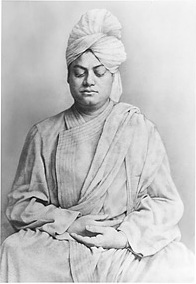
The term veda means "knowledge" and anta means "end", and originally referred to the Upanishads, a collection of foundational texts in Hinduism. Vedanta came to mean all philosophical traditions concerned with interpreting the three basic texts of Hinduist philosophy, namely the Upanishads, the Brahma Sutras and the Bhagavad Gita, and was eventually recognized as distinct from the other five astika schools. Vedanta is the most prominent and philosophically advanced of the orthodox (astika) schools. There are at least ten schools of Vedanta.
All schools of the vedanta propound their philosophy by interpreting the Prasthanatrayi, literally, three sources, the three canonical texts of Hindu philosophy, especially of the Vedanta schools. It consists of:
The schools of Vedānta seek to answer questions about the relation between atman and Brahman, and the relation between Brahman and the world. Ātman means 'inner-self' or 'soul'. Ātman is the first principle, the true self of an individual beyond identification with phenomena, the essence of an individual. In order to attain liberation, a human being must acquire self-knowledge (atma jnana), which is to realize that one's true self (Ātman) is identical with the transcendent self Brahman. Brahman is "the unchanging reality amidst and beyond the world", which "cannot be exactly defined". The schools of Vedanta are named after the relation they see between atman and Brahman:
The Vedas ("knowledge") are a large body of texts originating in ancient India. Composed in Vedic Sanskrit, the texts constitute the oldest layer of Sanskrit literature and the oldest scriptures of Hinduism. The Vedic texts or śruti are organized around four canonical collections of metrical material known as Sa ṃhitās, of which the first three are related to the performance of yajna (sacrifice) in historical Vedic religion:
The Upanishads are a collection of Vedic texts which contain the earliest emergence of some of the central religious concepts of Hinduism, Buddhism and Jainism. They are also known as Vedanta ("the end of the Veda") (see also The Wisdom of the Vedas, J. C. Chatterji, Quest Books, 1992 and The Principal Upanishads, Swami Nikhilananda, Courier Dover Publications, 2003).
The Mahabharata or Mahābhārata is one of the two major Sanskrit epics of ancient India, the other being the Ramayana. Besides its epic narrative of the Kurukshetra War and the fates of the Kaurava and the Pandava princes, the Mahabharata contains philosophical and devotional material, such as a discussion of the four "goals of life" or purusharthas. Among the principal works and stories in the Mahabharata are the Bhagavad Gita, the story of Damayanti, an abbreviated version of the Ramayana, and the Rishyasringa. The Bhagavad Gita is set in a narrative framework of a dialogue between Pandava prince Arjuna and his guide and charioteer the god-king Krishna. Facing the duty to kill his relatives, Arjuna is counselled by Krishna to "fulfill his Kshatriya (warrior) duty as a warrior and kill". TheBhagavad Gita presents a synthesis of the Brahmanical concept of Dharma, theistic bhakti, the yogic ideals of moksha through jnana, bhakti, karma, and Raja Yoga (spoken of in the 6th chapter) and Samkhya philosophy. The Ramayana depicts the duties of relationships, portraying ideal characters like the ideal father, the ideal servant, the ideal brother, the ideal wife, and the ideal king (see also The Great Epic of India: Character and Origin of the Mahabharata, Edward Washburn Hopkins, Motilal Banarsidass Publ., 1993 and Lessons from the Mahabharata, G. N. Das, Abhinav Publications, 1998)

 Hinduism
Hinduism
 Hinduism
Hinduism
 Hinduism
Hinduism
 Hinduism Today
Hinduism Today
 Hindu philosophy
Hindu philosophy
 Hindu Trinity
Hindu Trinity
 Brahma
Brahma
 Brahman
Brahman
 Brahman - The Absolute God of Hinduism
Brahman - The Absolute God of Hinduism
 Vishnu
Vishnu
 Shiva
Shiva
 The Philosophy of Brahman
The Philosophy of Brahman
 Vedas and Vedic Knowledge Online
Vedas and Vedic Knowledge Online
 Upanishads
Upanishads
 The Vedas
The Vedas
 Mahabharata
Mahabharata
 Advaita Vedanta Anusandhana Kendra
Advaita Vedanta Anusandhana Kendra
 Arsha Vidya Gurukulam
Arsha Vidya Gurukulam
 Swami Vivekananda
Swami Vivekananda
 Swami Vivekananda at the 1893 World Religion Parliament
Swami Vivekananda at the 1893 World Religion Parliament
 Sri Ramakrisha & Swami Vivekananda
Sri Ramakrisha & Swami Vivekananda
 Shaivism
Shaivism
 Shaktism
Shaktism
 Vaishnavism
Vaishnavism
 Smartism
Smartism
 Vedanta
Vedanta
 Samkhya
Samkhya
 Nyaya
Nyaya
 Yoga
Yoga
 Purva Mimamsa
Purva Mimamsa
 Vaisheshika
Vaisheshika
 Vaisheshika - Contributions to Physics
Vaisheshika - Contributions to Physics
 Sanskrit
Sanskrit
 Sanskrit tutor
Sanskrit tutor
 Astika and Nastika
Astika and Nastika

Buddhism (also known as the Dharma or Buddha Dharma, meaning approximately: The Law or Law of the Awakened One) is a religion, a practical philosophy, and arguably a psychology, focusing on the teachings of the Buddha Siddhartha Gautama (estim. 486-483 BCE), who lived in ancient India most likely from the mid-6th to the early 5th century BCE. The Western view on Buddhism was influenced by the Introduction à l'histoire du Bouddhisme indien (1844) of Eugène Burnouf (1801-1852 CE).
The Buddha's teachings center around two basic principles. One is the Four Noble Truths, in which the Buddha diagnoses the problem of suffering and indicates the treatment necessary to remedy this problem. The other is the Noble Eightfold Path, the practical discipline he prescribes to uproot and eliminate the deep underlying causes of suffering. The Four Noble Truths teach that suffering is inherent in life, but that through acknowledging the origins of suffering and following the Eightfold Path, suffering can be ceased (see also The Noble Eightfold Path: The Way to the End of Suffering, Bhikkhu Bodhi, Buddhist Publication Society, 2010 and Buddha, The Word: The Eightfold Path, Nyanatiloka, The Floating Press, 2009).
The basic goal of Buddhist philosophy is to achieve Enlightenment which can be defined as the full realization of the truth of the Buddha's teachings. Enlightenment or 'The Wisdom of Emptiness' is the wisdom that arises from the direct experience of all phenomena being empty of independent existence. Enlightenment can be defined as awakening to a great reality most of us never perceive. All things in the Universe are interconnected and interdependent, nothing in this world exists independently and everything and all constitutes a Cosmos. All things are connected and conditional or in other words all things exist because of other things. The Noble Eightfold Path (magga) is the way leading to the cessation of suffering (dukkha) and the achievement of self-awakening. Reaching Nirvana in Buddhism means 'The End of Suffering', both in this lifetime and all future lifetimes. The Buddha's first sermon after his Enlightenment centered on the Four Noble Truths, which are the foundation of Buddhism. The truths are:
The Noble Eightfold Path is one of the principal teachings of the Buddha, who described it as the
way leading to the cessation of suffering (dukkha) and the achievement of self-awakening. The Path is used to develop insight into the true nature of phenomena
(or reality) and to eradicate greed, hatred, and delusion.
The Eight Fold-Path of Buddhism consists of:
In addition there are two fruits as a result of following the Noble Eightfold Path:

In Buddhist symbolism, the Noble Eightfold Path is often represented by means of the dharma wheel (dharmachakra - ☸), whose eight spokes represent the eight elements of the path to Enlightnement and reaching Nirvana, a profound peace of mind that is acquired with moksha (liberation). This brings an end of all the suffering involved in being subject to the cycle of repeated death and rebirth (reincarnation). One could say that reaching illumination or awakening is crossing over the mystical bridge between the spatio-temporal realm (distinction between subject and object) into the quantum realm and its non-locality and entanglement which connects everything. One reaches Samādhi, or concentration of the mind, which is the last of the eight elements of the Noble Eightfold Path (see also Quantum Buddhism : Dancing in Emptiness - Reality Revealed at the Interface of Quantum Physics and Buddhist Philosophy, Graham Smetham, Lulu.com, 2010 and The Buddha Mind, Universe, and Awakening -- A dialogue between Master Sheng Yen and Astronaut Dr. Edgar Mitchell, Master Sheng Yen, Astronaut Dr. Edgar Mitchell, 2010 and Buddhism and Science: A Guide for the Perplexed, Donald S. Lopez Jr., University of Chicago Press, 2008).
A distinction is being made between the "Smaller Vehicle" (Hīnayāna or Theravada) and the "Great Vehicle" (Mahāyāna) tradition in Buddhism from a Mahāyāna point of view. Buddhism is divided primarily into three traditions or practice lineages: Theravada (Sanskrit: Sthaviravada), Mahāyāna and Vajrayana. Theravada is the oldest surviving branch of Buddhism. The name Theravada literally means "the Teaching of the Elders" and the Theravada school of Buddhism was the first one to emerge after the Buddha's parinirvana (Death). Over the centuries, it has retained its unique approach to the search for Nirvana, relying closely on the word of the Buddha as it appears in the Pāli Canon. Mahāyāna ("Great Vehicle") is one of two (or three, under some classifications) main existing branches of Buddhism and a term for classification of Buddhist philosophies and practice. The Mahāyāna form of Buddhism emerged somewhere between 150 BCE and 100CE. Its distinctive features include the new emphasis given to compassion and the Bodhisattva ideal, the three-bodies of the Buddha doctrine, emptiness and skill in means. the two main schools of Mahāyāna Buddhism in India were Madhyamaka and Yogācāra. Buddhists in the southern countries, such as Sri Lanka, Thailand, and Myanmar, carry on the Theravada practice lineage. The form of Buddhism that moved north and east, into China, Korea, and Japan, among others, is the Mahāyāna practice lineage. The Buddhist tradition of Vajrayana is sometimes classified as a part of Mahāyāna Buddhism, but some scholars may consider it as a different branch altogether. Vajrayāna refers to one of three vehicles or routes to enlightenment, the other two being the Śrāvakayāna (also known as the Hīnayāna) and Mahāyāna. Vajrayāna is also known as Tantric Buddhism and the Lama and the Guru yoga are central in this system. Hīnayāna is a Sanskrit term literally meaning: the "Smaller Vehicle", applied to the Śrāvakayāna, the Buddhist path followed by a śrāvaka who wishes to become an Arhat. In Theravada Buddhism, an Arhat ("one who is worthy") is a "perfected person" who has attained nirvana. The term 'Hīnayāna' appeared around the 1st or 2nd century. Hīnayāna is often contrasted with Mahāyāna, which means the "Great Vehicle" (see also An Introduction to Buddhism: Teachings, History and Practices, Peter Harvey, Cambridge University Press, 2012 and Buddhism as Philosophy: An Introduction, Mark Siderits, Ashgate Publishing, Ltd., 2007 and Boeddha en ik: ontmoeting in de diepte, Ulich Libbrecht, Lannoo, 2006 and From the Four Noble Truths to the Four Universal Vows: An Integration of the Mahayana and Theravada Schools, Xingyun, Hsing Yun, Buddha's Light Publishing, 2002).
Nāgārjuna (ca. 150-ca. 250 CE) is the most important Buddhist philosopher after the historical Buddha himself. The central concept of Nāgārjuna's philosophy is the notion of emptiness (Sanskrit: śūnyatā) of something or substance (Sanskrit: svabhāva). All phenomena are inherently empty of svabhāva or inherent existence, because they are dependently co-arisen. At a conventional level, "things" do exist, but ultimately they are "empty" of inherent existence. But this "emptiness" itself is also "empty": it does not have an existence on its own, nor does it refer to a transcendental reality beyond or above phenomenal reality. Along with his disciple Āryadeva (3rd century CE), Nāgārjuna is considered to be the founder of the Madhyamaka school of Mahāyāna Buddhism. His most important work is the Mūlamadhyamakakārikā (Fundamental Verses on the Middle Way). He developed the Buddhist doctrine of the two truths, which differentiates between two levels of truth (Sanskrit: satya) in Buddhist discourse: relative or commonsensical truth, and absolute or ultimate truth (see also Nāgārjuna and the Philosophy of Openness, Nancy McCagney, Rowman & Littlefield, 1997 and Mūlamadhyamakakārikā of Nāgārjuna, Nāgārjuna, David J. Kalupahana, Motilal Banarsidass Publ., 1996).
The path towards Enlightenment varies in the different schools of Buddhism. In Theravada Buddhism, reaching full awakening is equivalent in meaning to reaching Nirvāṇa. In Mahāyāna Buddhism the Bodhisattva is the ideal, who is an enlightened (bodhi) being (sattva). The ultimate goal is not only of one's own liberation in Buddhahood, but the liberation of all living beings. Attaining Nirvāṇa is the ultimate goal of Theravada and other śrāvaka traditions. There are ten hindrances (fetters) to enlightenment and four stages of realization (enlightenment) based on how many hindrances have been eliminated and/or the degree to which they have been eliminated. Enlightenment or reaching Nirvāṇa involves the abandonment of the ten fetters and the cessation of dukkha or suffering. In Buddhism, a mental fetter, chain or bond (Pāli: samyojana) shackles a sentient being to saṃsāra, the cycle of lives with dukkha. The ten fetters are being deivied into two groups, where the first five fetters are referred to as "lower fetters" (orambhāgiyāni saṃyojanāni) and are eradicated upon becoming a non-returner; and, the last five fetters are referred to as "higher fetters" (uddhambhāgiyāni saṃyojanāni), eradicated by an Arahant. In summary, the Pāli Canon's Sutta Pitaka identifies ten "fetters of becoming" as follows:
Zen Buddhism is a branch of Mahāyāna Buddhism that developed in China during the 6th century as Chán. From China, Zen spread south to Vietnam, northeast to Korea and east to Japan. Zen emphasizes insight into Buddha-nature and the personal expression of this insight in daily life, especially for the benefit of others. As such, Zen deemphasizes mere knowledge of sutras and doctrine and favors direct understanding (illumination, awakening) through zazen and interaction with an accomplished teacher (An Introduction to Zen Buddhism, Daisetz Teitaro Suzuki Suzuki, Grove Press, 2007).
Classical Chinese Chán is characterised by a set of polarities: absolute-relative, Buddha-nature - sunyata, sudden and gradual enlightenment, esoteric and exoteric transmission. The Prajnaparamita-sutras and Madhyamaka emphasized the non-duality of form and emptiness: "form is emptiness, emptiness is form", as the heart sutra says. This was understood to mean that ultimate reality is not a transcendental realm, but equal to the daily world of relative reality. The doctrine of the Buddha-nature asserts that all sentient beings have Buddha-nature ("Buddha Element", "Buddha-Principle"), the element from which awakening springs. Buddha-nature or Buddha Principle refers to several related terms, most notably Tathāgatagarbha and Buddhadhātu. Tathāgatagarbha means "the womb" or "embryo" (garbha) of the "thus-gone" (tathagata), or "containing a tathagata", while Buddhadhātu literally means "Buddha-realm" or "Buddha-substrate". The Tathāgatagarbha Sutras (literally: the womb of the thus-gone) state that every living being has the potential to realize awakening. Hence Buddhism offers salvation to every-one, not only to monks or those who have freed themselves almost completely from karma in previous lives. When this Buddha-nature is realised, it turns into the Dharmadhatu, the "dimension", "realm" or "sphere" (dhatu) of Dharma, or "absolute Reality". In Zen Buddhism two main views on the way to enlightenment are discernible, namely sudden and gradual enlightenment. Early Chán recognized the "transcendence of the body and mind", followed by "non-defilement [of] knowledge and perception", meaning sudden insight into the true nature followed by gradual purification of intentions. A distinction is being made between esoteric and exoteric transmission. The 'mind to mind transmission' is a form of esoteric transmission, in which "the tradition and the enlightened mind is transmitted face to face". Metaphorically this can be described as the transmission from a flame from one candle to another candle, or the transmission from one vein to another. In exoteric transmission it requires "direct access to the teaching through a personal discovery of one's self (know thyself). This type of transmission and identification is symbolized by the discovery of a shining lantern, or a mirror" (see also Manual of Zen Buddhism, Daisetz Teitaro Suzuki, Filiquarian Publishing, LLC., 2007 and Japanese Rinzai Zen Buddhism, J. Borup, BRILL, 2008, p. 9).
The corpus of Buddhism is being into three categories, based on ways of understanding the nature of reality, known as the "Three Turnings of the Dharma Wheel". Buddha's first sermons, as recorded in the Pāli Canon and the Tripiṭakas of other early schools, constitute the First Turning, and the later Mahāyāna Sūtras comprise the Second and Third turnings. In the first turning, the Buddha taught the Four Noble Truths at Varanasi for those in the śravaka vehicle. In the second turning, the Buddha taught the Mahāyāna teachings to the bodhisattvas, teaching that all phenomena have no-essence, no arising, no passing away, are originally quiescent, and essentially in cessation. In the third turning, the Buddha taught similar teachings to the second turning, but for everyone in the three vehicles, including all the śravakas, pratyekabuddha, and bodhisattvas (see also Mysteries of the World According to Buddhism, Khenpo Sodargye, BICW USA, 2013, p. 12 and The Third Turning of the Wheel: Wisdom of the Samdhinirmocana Sutra, Reb Anderson, James Coleman, Rodmell Press, 2012).
The Pāli Canon is the standard collection of scriptures in the Theravadan Buddhist tradition, as preserved in the Pāli language. It is the first known and most complete extant early Buddhist canon. The traditional Buddhist writings are being classified into three basic collections, the Tripiṭaka (Pali: Tipiṭaka) meaning Three Baskets (Nikāya>) in Sanskrit. The Tripiṭaka traditionally contains three "baskets" of teachings: a Sūtra Piṭaka (Sanskrit; Pali: Sutta Pitaka), a Vinaya Piṭaka (Sanskrit and Pali) and an Abhidharma Piṭaka (Sanskrit; Pali: Abhidhamma Piṭaka). The Sūtra Piṭaka is a collection of suttas, or discourses, attributed to the Buddha and a few of his closest disciples, containing all the central teachings of Buddhism. The Vinaya Piṭaka concerns the rules of conduct governing the daily affairs within the Sangha - the community of bhikkhus (ordained monks) and bhikkhunis (ordained nuns). The seven books of the Abhidhamma Pitaka, the third division of the Tipitaka, offer an analysis of the basic natural principles that govern mental and physical processes. Whereas the Sūtra Piṭaka and Vinaya Piṭaka lay out the practical aspects of the Buddhist path to Awakening, the Abhidhamma Pitaka provides a theoretical framework to explain the causal underpinnings of that very path. In Abhidhamma philosophy the familiar psycho-physical universe (our world of "trees" and "rocks", "I" and "you") is distilled to its essence: an intricate web of impersonal phenomena and processes unfolding at an inconceivably rapid pace from moment to moment, according to precisely defined natural laws (see also Pain and Its Ending: The Four Noble Truths in the Theravada Buddhist Canon, Carol Anderson, Routledge, 2013).
Several parables are attributed to the Buddha, such as the parable of the water-snake and the parable of the raft. Both parables appears in the Alagaddupama Sutta (Water Snake Simile) of the Sutta Pitaka (Majjhima Nikaya 22). The Majjhima Nikaya, or "Middle-length Discourses" of the Buddha, is the second of the five nikayas (collections) of the Sutta Pitaka. In this sutta, the Buddha discusses the importance of learning the Dhamma (Dhamma (Pali) or Dharma (Sanskrit)) properly and the danger of clinging to views. The Sutta begins with an account of the monk Arittha, who was clinging to flawed views based on misunderstanding of the Dharma. The other monks argued with him, but Arittha would not budge from his position. Eventually the Buddha was called upon to arbitrate. After correcting Arittha's misunderstanding, the Buddha followed up with two parables. The first parable is about a water snake, and the second is the parable of the raft. The simile of the snake, is about a man who grasps to a snake unwisely and finds that the snake has opportunity and cause to attack and injure (or kill) the man. But a man who wisely grasps the snake find that he is safe from harm. This is true of the Dhamma as it is with the snake. It takes right skill and right understanding to wisely grasp either. The raft parable is one of the best known of the Buddha's many parables and similes: A man travelling along a path came to a great expanse of water. As he stood on the shore, he realized there were dangers and discomforts all about. But the other shore appeared safe and inviting. The man looked for a boat or a bridge and found neither. But with great effort he gathered grass, twigs and branches and tied them all together to make a simple raft. Relying on the raft to keep himself afloat, the man paddled with his hands and feet and reached the safety of the other shore. He could continue his journey on dry land. Now, what would he do with his makeshift raft? Would he drag it along with him or leave it behind? He would leave it, the Buddha said. Then the Buddha explained that the Dhamma is like a raft. It is useful for crossing over but not for holding onto, he said. The raft parable reminds us that the Noble Eightfold Path is here to help us, to carry us across the water. Once man has passed the troubled waters and arrived at its destiny the tools are no longer needed. But it is only when man has completed his journey does he leave the raft behind (see also A Manual of Buddhism: For Advanced Students, Caroline Augusta Foley Rhys Davids, Asian Educational Services, 1932, p. 226 and Early Buddhist Discourses, John J. Holder, Hackett Publishing, 2006, p. 102 and A Conceptual-analytic Study of Classical Indian Philosophy of Morals, Rajendra Prasad, Concept Publishing Company, 2008).
The Mahāyāna Sūtras are a broad genre of Buddhist scriptures that various traditions of Mahāyāna Buddhism accept as canonical. The Lotus Sūtra (Sanskrit: Saddharma Puṇḍarīka Sūtra) is one of the most popular and influential Mahāyāna sūtras. The Lotus Sūtra extensively deals with instruction on the concept and usage of skillful means in several parables. Teaching has to be adapted to the level of development of the apprentice. The sutra emphasizes that all these seemingly different teachings are actually just skillful applications of the one dharma and thus all constitute the "One Buddha Vehicle and knowledge of all modes". The Lotus Sūtra teaches that all people equally can attain Buddhahood in their present form as Buddhahood is part of everyone's (inner) existence only waiting to be awakened. The Buddha is also an eternal entity, who achieved nirvana eons ago, but remains in the world to help teach beings the Dharma time and again. In Mahāyāna Buddhism the Heart Sūtra and the Diamond Sūtra both belong to Perfection of Wisdom (Prajñāpāramitā) category of Mahāyāna Buddhism literature. These Sūtras are associated with the second turning of the Dharma wheel. The significance of the second turning is the development of the doctrine of Sunyata and the ideal of the Bodhisattva who brings all beings to enlightenment. The Diamond Sūtra deals with lessons on emptiness, the potential of all phenomena, ourselves and the dharma. The Heart Sūtra teaches the essence of Buddhism, which is Emptiness and thereby teaches the 'heart' of the Mahāyāna, primarily in terms of the view. The meaning is essentially that by letting go of your preconceived notions, opinions, and attachments, you can become open to all the wonders of our life. All things are empty. This is the realization of nothingness. But, emptiness or nothingness does not just mean nothing. It means not being attached to anything; especially your own perceptions and ideas so that you can see your life clearly. The main theme of the Heart Sūtra and the other Prajñāpāramitā Sūtras is the basic groundlessness of our experience. These Sūtras say that no matter what man does, no matter what man says, and no matter what man feels, one need not believe any of it. There is nothing whatsoever to hold on to, and even that is not sure. Thus, the Heart Sūtra teaches emptiness through the epitome of compassion. Emptiness is the heart of the Mahāyāna, but the heart of emptiness is compassion. The Heart Sūtra teaches that "form is emptiness, emptiness is form". It contains the mantra "gate gate paragate parasamgate bodhi svaha", meaning "Gone, gone, gone all the way over, everyone gone to the other shore, enlightenment, svaha!" (svaha is a cry of joy or excitement). In addition to teaching about emptiness, the Prajñāpāramitā Sūtras also speak about the path in great detail, such as how to cultivate loving-kindness and compassion, how to do certain meditations, and how to progress through the paths (see also The Heart Sutra Explained: Indian and Tibetan Commentaries, Donald S. Lopez, SUNY Press, 1988 and The Heart Sutra, Red Pine, Counterpoint Press, 2005 and The Diamond Sutra: Transforming the Way We Perceive the World, Mu Soeng, Wisdom Publications, 2011).
 Buddhism
Buddhism
 Buddhism
Buddhism
 Introduction to Buddhism
Introduction to Buddhism
 The Buddha and his Dhamma
The Buddha and his Dhamma
 Dhammapada
Dhammapada
 Four Noble Truths
Four Noble Truths
 Dharmacakra - wheel of law
Dharmacakra - wheel of law
 Buddhism - Essentials
Buddhism - Essentials
 History of Buddhism
History of Buddhism
 Schools of Buddhism
Schools of Buddhism
 Mahayana vs. Theravada
Mahayana vs. Theravada
 Readings in Theravada Buddhism
Readings in Theravada Buddhism
 Mahayana Mahaparinirvana Sutra
Mahayana Mahaparinirvana Sutra
 The Eastern Buddhist Society
The Eastern Buddhist Society
 Buddhanet.net
Buddhanet.net
 Zen Buddhism WWW Virtual Library
Zen Buddhism WWW Virtual Library
 Shunkoin Temple - Japan
Shunkoin Temple - Japan
 The Silk Road - spreading of Buddhism
The Silk Road - spreading of Buddhism
 Ashoka the Great - (304 BC-232 BCE)
Ashoka the Great - (304 BC-232 BCE)
 Edicts of Ashoka - Ashoka
Edicts of Ashoka - Ashoka
 Edicts of Ashoka - Ashoka
Edicts of Ashoka - Ashoka
 Edicts of Ashoka - Ashoka
Edicts of Ashoka - Ashoka
 Greco-Buddhism
Greco-Buddhism
 Greco-Buddhism
Greco-Buddhism
 Yona
Yona
 Buddhism and the Roman world
Buddhism and the Roman world
 Buddhist-Christian Parallels
Buddhist-Christian Parallels
 Mandala
Mandala
 Introduction to Mandalas - Tibetan Buddhism
Introduction to Mandalas - Tibetan Buddhism
 Huineng - (638-713 CE)
Huineng - (638-713 CE)
 Fa Xian - (ca. 337-ca. 422 CE)
Fa Xian - (ca. 337-ca. 422 CE)
 Honen Bo Genku- (1133-1212 CE)
Honen Bo Genku- (1133-1212 CE)
 Myoan Eisai - (1141-1215 CE)
Myoan Eisai - (1141-1215 CE)
 Shinran Shonin - (1173-1262 CE)
Shinran Shonin - (1173-1262 CE)
 Dogen Zenji - (1200-1253 CE)
Dogen Zenji - (1200-1253 CE)
 Nichiren - (1222-1282 CE)
Nichiren - (1222-1282 CE)
 Daisetz Teitaro Suzuki - (1870-1966 CE)
Daisetz Teitaro Suzuki - (1870-1966 CE)

Sikhism
is a religion that began in sixteenth century Northern India with the teachings of Guru
Nanak (1469-1539 CE) and nine successive
human Gurus.
This system of religious philosophy and expression has been traditionally known as the
Gurmat (literally the teachings of the Gurus) or the Sikh Dharma.
Guru Nanak (1469-1539 CE) formalised the
Three Pillars of Sikhism:
The founder of the Sikh religion was Guru Nanak (1469-1539 CE). He preached a message of love and understanding and criticized the blind rituals of the Hindus and Muslims. Guru Nanak passed on his enlightened leadership of this new religion to nine successive Gurus. The final living Guru of Sikhism was Guru Guru Gobind Singh (1666-1708 CE). During his lifetime Guru Gobind Singh established the Khalsa order (meaning 'The Pure'), soldier-saints. The Khalsa uphold the highest Sikh virtues of commitment, dedication and a social conscious. The Khalsa are men and women who have undergone the Sikh baptism ceremony and who strictly follow the Sikh Code of Conduct and Conventions and wear the prescribed physical articles of the faith. One of the more noticeable being the uncut hair (required to be covered with a turban for men) and the Kirpan (ceremonial sword). Before his death in 1708 Guru Gobind Singh declared that the Sikhs no longer needed a living and appointed his spiritual successor as Sri Guru Granth Sahib, his physical successor as the Khalsa. Guru Gobind Singh felt that all the wisdom needed by Sikhs for spiritual guidance in their daily lives could be found in Sri Guru Granth Sahib, the Eternal Guru of the Sikhs. Sri Guru Granth Sahib is unique in the world of religious scriptures because not only is it accorded the status of being the spiritual head of the Sikh religion, but besides the poetry of the Gurus, it also contains the writings of saints of other faiths whose thoughts were consistent with those of the Sikh Gurus. Sikhism does not have priests, which were abolished by Guru Gobind Singh. The Guru felt that they had become corrupt and full of ego. Sikhs only have custodians of the Guru Granth Sahib (granthi), and any Sikh is free to read the Guru Granth Sahib in the Gurdwara (a Sikh temple) or in their home. All people of all religions are welcome to the Gurdwara. A free community kitchen can be found at every Gurdwara which serves meals to all people of all faiths. Guru Nanak first started this institution which outline the basic Sikh principles of service, humility and equality. The most significant historical religious center for the Sikhs is Harmiandir Sahib (The Golden Temple) at Amritsar in the state of Punjab in northern India. It is the inspirational and historical center of Sikhism but is not a mandatory place of pilgrimage or worship. All places where Sri Guru Granth Sahib are installed are considered equally holy for Sikhs (see also Sikhism, Jane Bingham, Black Rabbit Books, 2007 and Philosophy of Sikhism: Reality and Its Manifestations, Nirbhai Singh, Atlantic Publishers & Distri, 1990).
The philosophy and beliefs of Sikhism can be summarized as follows:
Adi Granth, which literally means 'the first book' is the early compilation of the Sikh Scriptures by Guru Arjun Dev (1563-1606 CE), the fifth Sikh Guru, in 1604. This Granth (Book) is the Holy Scripture of the Sikhs. The tenth Sikh Guru, Guru Gobind Singh (1666-1708 CE) added further holy Shabads (hymns) to this Granth during the period 1704 to 1706. Then in 1708, before taking leave for his heavenly abode, Guru Gobind Singh affirmed the Adi Granth as the perpetual Guru of the Sikhs and the Granth then became known as the Sri Guru Granth Sahib. 20 October 1708 was the date of the installation of the Guru Granth Sahib as eternal Guru.
Guru Granth Sahib is the central religious text of Sikhism, considered by Sikhs to be the final, sovereign guru among the lineage of 11 Sikh Gurus of the religion. Sri Guru Granth Sahib is unique in the world of religious scriptures as is it accorded the status of being the spiritual head of a major religion. The Japji hymn by Guru Nanak Dev (1469-1539 CE) is considered to be the key to Sri Guru Granth Sahib and an epitome of the Sikh doctrine. It appears as the first poem in Sri Guru Granth Sahib and is repeated by Sikhs in their morning prayers, as well as when preparing Amrit for the Khalsa baptism ceremony. Japji lays stress on the brotherhood of man and remembrance of God as the key to salvation (see also Selections from the Sacred Writings of the Sikhs, Trilochan Singh, Orient Blackswan, 2000).
 Sikhism
Sikhism
 Sikhism
Sikhism
 Sikhism
Sikhism
 All about Sikhs
All about Sikhs
 Amrit World
Amrit World
 Kabira
Kabira
 Gurmat
Gurmat
 Gurmat
Gurmat
 Selected writings
Selected writings
 Guru Nanak Dev - (1469-1539 CE)
Guru Nanak Dev - (1469-1539 CE)
 Guru Angad Dev - (1504-1552 CE)
Guru Angad Dev - (1504-1552 CE)
 Guru Amar Das - (1479-1574 CE)
Guru Amar Das - (1479-1574 CE)
 Guru Ram Das - (1534-1581 CE)
Guru Ram Das - (1534-1581 CE)
 Guru Arjun Dev - (1563-1606 CE)
Guru Arjun Dev - (1563-1606 CE)
 Guru Har Gobind - (1595-1644 CE)
Guru Har Gobind - (1595-1644 CE)
 Guru Har Rai - (1630-1661 CE)
Guru Har Rai - (1630-1661 CE)
 Guru Har Krishan - (1656-1664 CE)
Guru Har Krishan - (1656-1664 CE)
 Guru Teg Bahadur - (1621-1675 CE)
Guru Teg Bahadur - (1621-1675 CE)
 Guru Gobind Singh - (1666-1708 CE)
Guru Gobind Singh - (1666-1708 CE)

Jainism, traditionally known as Jain Dharma, is a religion and philosophy originating in the prehistory of South Asia. Jainism stresses the spiritual independence and equality of all life with a particular emphasis on non-violence. The supreme ideal of the Jain religion is nonviolence (Ahimsa), equal kindness, and reverence for all forms of life in speech, thought, and action.Jain philosophy has three core practices: Non-Violence (Ahimsa), Non-Absolutism (Anekantavad), and Non-Possessiveness (Aparigraha). Non-Violence is compassion and forgiveness in thoughts, words, and deeds towards all living beings. For this reason, Jains are vegetarians. Non-Absolutism is respect for and seeking others' views. Jains encourage dialogue and harmony with other faiths. Non-Possessiveness means balancing of needs and desires, while staying detached from these possessions. Humans are all interdependent on each other and we can bring peace to our lives and to those around us. Jains seek spiritual upliftment by practicing Non-Violence, Non-Absolutism, and Non-Possessiveness. Jains believe in the existence of Soul (Atma) - in each living being - which is eternal and divine. The Jain purpose in life is to "know ourselves" and that happiness and knowledge exist in me. Self-control (vrata) is the means by which Jains attain moksha, Keval Gnan (Knowledge of the Self to Absolute Knowledge), or realization of the soul's true nature. Keval Gnan is a state of permanent, perpetual, absolute knowledge of the Soul; it is the precursor to moksha. Gnan is an integral and most valuable auspicious characteristic of each soul (Atma). Just like a lamp brightens - illuminates the darkest space, Gnan enlightens many dark spots of our souls. There are Five types of Gnans:
The triple gems of Jainism (Ratnatraya) the right vision or view (Samyak Darshana), right knowledge (Samyak Gyana) and right conduct (Samyak Charitra) constitutes the path to liberation and for the soul to move up spiritually. One can get rid of karma and attain liberation by simultaneously following the path of right faith (samyak-darshana), right knowledge (samyak-jnana), and right conduct (samyak-charitra). The proper knowledge of the six universal substances (six Dravya) and the nine fundamental truths (nine Tattva) is called right knowledge and true faith in that knowledge is called right faith. Perfect spiritual development resulting from an absence of bondage and of its causes is called moksha. The Doors of Inflow of Karmas prevent one of attaining moksha, such as the 4 Passions (Anger, Pride (Ego), Deceit, Greed), the 5 Senses (Touch, Taste, Smell, Sight, Hearing) and the 5 Indulgences (Causing Injury, Lying, Stealing, Incontinence, Possessiveness). Once a person eradicates all Karmas, he will be liberated. There are 14 Gunsthanas or stages a person must pass through to achieve liberation and reach the state of complete dissociation from karma.
All Jain sects consider Shri Tattvärtha-sutra unanimously as the main Jain textbook today. The two others include Shri Uttarädhyayan Sutra (Shvetämbar scripture), and Shri Samaysär (Digambar sacred book) (see also Jainism: An Indian Religion of Salvation, Helmuth von Glasenapp, Motilal Banarsidass Publ., 1999, p. 109).
The Shri Tattvärtha-sutra focuses on the process we apply even today to get useful knowledge.
The nine tattvas,
or principles, are the single most important subject of Jain philosophy. It deals with the karma theory of
Jainism, which provides the basis for the path of liberation. Without the proper knowledge of this subject, a person can not
progress spiritually. The true faith and understanding of this subject brings about right faith (samyak-darshana), right
knowledge (samyak-jnana), and right conduct in an individual.
Samyak-darshana means quality, characteristic, energy, power, whose development brings about a realization of truth-that-is,
of the nature of things as they are an inclination towards valid discrimination between what is worthy of rejection and what
is worthy of acceptance is samyak-darshana or right (perfect, enlightened) inclination (perception, belief, faith, world-view).
Samyak-jnäna: A valid (true) comprehension of the fundamental verities (categories of truth, realities, fundamental truths)
like soul etc. This is a comprehension arrived at through the instrumentality of naya and pramäna - is samyak-jnäna or right
cognition (knowledge).
Samyak-chäritra: With right knowledge, one gets rid of all passions such as anger, ego, deceit and greed
- all attachment and hatred - enjoys his/her own nature is samyak-chäritra or right conduct.
This involves no Yoga - no physical, verbal and mental activities.
The spiritual path is determined by this integrated trinity. Not one, not two but all three are needed to attain Moksha.
The order of attainment is first Samyak-darshan, second Samyak-jnäna and last Samyak-chäritra. Samyak-darshan and
Samyak-jnäna are like light and heat of sun - they always happen together.
 Jainism
Jainism
 Jain belief
Jain belief
 Jainism
Jainism
 Jainism
Jainism
 Jinvani
Jinvani
 Jainworld
Jainworld
 Jain Heritage Centres
Jain Heritage Centres
 Sure and Pure religion
Sure and Pure religion
 Structural View of the Universe
Structural View of the Universe
 Five Great Vows
Five Great Vows
 Tattva
Tattva
The term Shinto ("way of the Kami") came into use to distinguish indigenous Japanese beliefs from Buddhism, which had been introduced into Japan in the 6th century CE. Shinto has no founder and no official scripture, though its mythology is collected in the Kojiki ("Records of Ancient Matters") and Nihon shoki ("Chronicles of Japan"), written in the 8th century.

 Shinto
Shinto
 Shinto
Shinto
 Encyclopedia of Shintoism
Encyclopedia of Shintoism
 Shinto Shrines
Shinto Shrines
 Shinto
Shinto
 Shinto Scripture
Shinto Scripture
 The Kojiki - translated by Basil Hall Chamberlain (1919 CE)
The Kojiki - translated by Basil Hall Chamberlain (1919 CE)
 The Kojiki - translated by Basil Hall Chamberlain (1919 CE)
The Kojiki - translated by Basil Hall Chamberlain (1919 CE)
 Holy Nihongi
Holy Nihongi
Africa is the cradle of humanity. Religion in Africa is very diverse and part of african spirituality. Most Africans adhere to either Christianity (Protestanism or Roman Catholicism) or Islam. Adherents of either Islam or Christianity also practice African traditional religions, with traditions of folk religion or syncretism practised alongside Christianity or Islam. African traditional religions share some common features: a belief in one God above a host of lesser gods or semi-divine figures; a belief in ancestral spirits; the idea of sacrifice, often involving the death of a living thing, to ensure divine protection and generosity; the need to undergo rites of passage to move from childhood to adulthood, from life to death. There are four foundational religious beliefs in the traditional African religions:
African traditional religion has had a powerful effect on political change: spirit mediums have led revolts against European colonialism (e.g. Mau Mau Uprising) and African rulers, ancestral spirits have commanded acts of destruction and called for the overthrow of rulers and chiefs.

 African religion
African religion
 African traditional religion
African traditional religion
 African traditional religion
African traditional religion
 Atoms and Ancestors - Fred Welbourn
Atoms and Ancestors - Fred Welbourn
Precolombian religion in America declined after the conquest of America by the Europeans. Aztec religion is the Mesoamerican religion practiced by the Aztec empire in Central America. Aztec religion had elements of human sacrifice in connection with a large number of religious festivals which were held according to patterns of the Aztec calendar. They were particularly concerned with the destructive aspect of nature, and most of their rituals are means of avoiding the destructive and chaotic forces of nature, and finding harmony within nature.
The world was conceived as a flat surface divided into five directions (norht, south, east, west and the center where their capital Tenochtitlán was located). Departing from Tenochtitlán, there was a vertical line with thirteen ascending layers or heavens, and nine layers of underworld all of them ocupied by different deities. Their pantheon was organized hierarchically with gods occupying the various vertical levels. The Aztec pantheon was quite large and varied. There were gods related to the creation of the cosmos, to fertility, regeneration, death, war, and the sacrificial nourishment of the sun. The gods had different roles and were also represented in different ways. The two gods to whom the two most important temples in the Aztec world were dedicated were Huitzilopochtli (the supreme deity of the Aztecs associated with sun and fire) and Tatloc, the rain god, that among other things was associated with fertility.
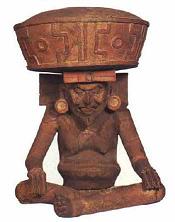
 Aztec Religion
Aztec Religion
 The Gods and Goddesses of the Aztecs
The Gods and Goddesses of the Aztecs
 Aztec religious texts
Aztec religious texts
 Aztecs
Aztecs
 Maya mythology
Maya mythology
 Mayan religious texts
Mayan religious texts
 Native American Spirituality
Native American Spirituality
 Native American Spirituality
Native American Spirituality
 Native American Spirituality in Early America
Native American Spirituality in Early America
 Rastafari movement
Rastafari movement
 Gurdjieff Foundation
Gurdjieff Foundation
Aboriginal religion is characterised by having a god or gods who created people and the surrounding environment during a particular creation period at the beginning of time. Australian Aboriginal people believe that in the beginning of the time, there were creation beings that rose out of the ground and created landscape features, plants and animals. A key aspect of Australian aboriginal belief is the Dreaming. Australian Aboriginal mythhological stories or Dreamtime stories are the stories traditionally performed by Aboriginal peoples concerning the creativity of Ancestral Beings. At the heart of this is the belief in powerful beings who arose out of the land, created or gave birth to people, plant life and animal life, and connected particular groups of people with particular regions and languages. The Dreaming beings continue to control the natural world, but their willingness to release the powers of fertility depends upon people continuing to perform certain rituals.

 Australian Aboriginal religions
Australian Aboriginal religions
 Aboriginal religion
Aboriginal religion
 Aboriginal religion
Aboriginal religion
 Australian Aboriginal religions
Australian Aboriginal religions
 Australian Aboriginal religion - Dreamtime
Australian Aboriginal religion - Dreamtime
The New Age movement is a Western spiritual movement that developed in the second half of the 20th century. Its central precepts have been described as "drawing on both Eastern and Western spiritual and metaphysical traditions and infusing them with influences from self-help and motivational psychology, holistic health, parapsychology, consciousness research and quantum physics". New Age draws its inspiration from a wide variety of spiritual and esoteric traditions.
The Kybalion (1908 CE), written by William Walker Atkinson put forward so-called Seven Hermetic principles:
 New Age
New Age
 New Age
New Age
 Emanuel Swedenborg - (1688-1772 CE)
Emanuel Swedenborg - (1688-1772 CE)
 Franz Anton Mesmer - (1734-1815 CE)
Franz Anton Mesmer - (1734-1815 CE)
 George Ivanovich Gurdjieff - (1866-1949 CE)
George Ivanovich Gurdjieff - (1866-1949 CE)
 Swami Vivekananda - (1863-1902 CE)
Swami Vivekananda - (1863-1902 CE)
 Edgar Cayce - (1877-1945) CE)
Edgar Cayce - (1877-1945) CE)

Theosophy is a philosophical system having affinities with mysticism and claiming insight into the nature of God and the world through direct knowledge, philosophical speculation, or some physical process. This system of thought differs from many other philosophical positions in that it begins with an assumption of the absolute reality of the essence of God, from which it deduces the essentially spiritual nature of the universe. Other assumptions frequently found in theosophical doctrine are that God is the transcendent source of all being and all good; that evil exists in the world because of human desire for finite goods and may be overcome by complete absorption in the infinite; and that sacred writings and doctrines are interpreted through allegory. This is the position of much speculative mysticism. However, mysticism generally confines itself to the soul's relation to God, while the theosophist uses these theories to formulate a complete philosophy of humanity and nature. Theosophy can also be understood as the search or and the study of the philosophia perennis or "Ageless Wisdom", which views each of the world's religious traditions as sharing a single, universal truth from which all esoteric and exoteric knowledge and doctrine has stemmed from. Theosophists believe that all religions have an element of the truth. One of its objects is to form a universal brotherhood without distinction according to race, sex or creed, ethnicity or religion (see also Ken Wilber: Thought as Passion, Frank Visser, SUNY Press, 2012, p. 277 and Holistic Learning and Spirituality in Education: Breaking New Ground, John P. Miller, Selia Karsten , Diana Denton, Deborah Orr, Isabella Colalillo Kates, SUNY Press, 2012, p. 22).
Modern Theosophy is a form of religious philosophy and metaphysics originating with Helena Petrovna Blavatsky (1831-1891 CE). Her most important works are Isis Unveiled (1877) and The Secret Doctrine (1888). Theosophy holds that all religions are attempts to help humanity in evolving to greater perfection, and that each religion therefore has a portion of the truth.
Theosophy, according to Helena Petrovna Blavatsky, has three objectives:
Early traces of ancient theosophy date back to the Hellenistic Alexandrian culture which expressed religion through a syncretism that included influences from Egypt, Chaldea, Greece etc. It became a "philosophizing and systematizing" culture containing mythology, theosophy and gnosis of the East. The Neoplatonists, the Gnostics and the kabbalists are generally considered early types of theosophists. Jakob Böhme (1575-1624 CE), regarded as the father of modern theosophy, developed a complete theosophical system attempting to reconcile the existence of an all-powerful and all-good God with the presence of evil in the world (theodicy). His most important work is Aurora or Die Morgenroete im Aufgang (1612) The philosophy and theology of Asia, especially of India, contain a vast body of theosophical doctrine. Modern theosophy draws much of its vocabulary from Indian sources. The Theosophical Society, with which theosophy is now generally identified, was founded in 1875 by Helena Petrovna Blavatsky; associated with her were Henry Steel Olcott (1832-1907 CE) and William Quan Judge (1851-1896 CE). Annie Besant (1847-1933 CE) was another influential thesophical author, such as her works The Ancient Wisdom and Occult Chemistry. Annie Besant was also a social reformer who advocated for the independence and religious rights of women and got involved in Indian politics while living in India. Alice Bailey (1880-1949 CE) wrote several books on theosophical subjects, and was one of the first writers to use the term New Age. Nicholas Roerich (1874-1947 CE) a Russian theosophist provided the inspiration for the Roerich Pact or 'Treaty on the Protection of Artistic and Scientific Institutions and Historic Monuments'. Rudolf Steiner's (1861-1925 CE) anthroposophy was closely linked to theosophy. Little known is that Youra Livchitz (1917-1944 CE), one of the participants in the attack on the twentieth convoy (19 April 1943), a Holocaust train in Belgium, had been a member of a theosophist community 'La Monada' in Brussels (see also Pedro Páramo, Marion Schreiber, Grove Press, 2005, p. 247). His mother Rachel was a theosophist. Aldous Huxley (1894-1963 CE) in The Perennial Philosophy wrote a comparative study of mysticism, which was based on the theological tradition of the philosophia perennis. Theosophy as a study of the 'philosophia perennis' can be regarded as the comparative study of theological traditions in order to find out what unites religions and metaphysical (transcendent) traditions. It could be a way to enable people to live together in a multicultural and globalized environment, without the need to engage in religious intolerance and religious wars (see also The Political Thought of Annie Besant, Concept Publishing Company, 2009 and Never again: what you do matters, Daniel Kennedy, Jr., p. 33 and Theosophy and Culture: Nicholas Roerich, Anita Stasulane, Gregorian Biblical BookShop, 2005, p. 185 and Isaiah Berlin: A Value Pluralist and Humanist View of Human Nature and the Meaning of Life, Connie Aarsbergen-Ligtvoet, Rodopi, 2006, p. 141 and The Underlying Religion: An Introduction to the Perennial Philosophy, Martin Lings, Clinton Minnaar, World Wisdom, Inc, 2007, p. 219 and Psychology and the Perennial Philosophy: Studies in Comparative Religion, Samuel Bendeck Sotillos, World Wisdom, Inc, 2013, p. 58 and Beyond the Postmodern Mind: The Place of Meaning in a Global Civilization, Huston Smith, Quest Books, 2013, p. 57 and Introduction to Globalization: Political and Economic Perspectives for the New Century, Rosa Gomez Dierks, Rowman & Littlefield, 2001, p. 257).
 Theosophical Society - Adyar
Theosophical Society - Adyar
 Theosophical Society - America
Theosophical Society - America
 Anand Gholap
Anand Gholap
 Theosophy texts
Theosophy texts
 Jakob Böhme texts
Jakob Böhme texts

The sole fact that a religion is being mentioned on this page does not mean that the author agrees with its ideas, nor that he is a member of this religion or in any way has a relation with it.
The information contained in this website is for general information purposes only.
The information is provided by me in good faith and while I endeavor to keep the information up to date and correct,
I make no representations or warranties of any kind, express or implied, about the completeness,
accuracy, reliability, suitability or availability with respect to the website or the information,
products, services, or related graphics contained on the website for any purpose.
Any reliance you place on such information is therefore strictly at your own risk.
Any information on this website is provided in good faith but no warranty can be
made for its accuracy. As this is a work in progress, it is still incomplete
and even inaccurate. Although care has been taken in preparing the information
contained in my webpages, I do not and cannot guarantee the accuracy thereof.
Anyone using the information does so at their own risk and shall be deemed
to indemnify me from any and all injury or damage arising from such use.
In no event shall I be liable for any loss or damage including without limitation, indirect or consequential loss or damage, or any loss or damage whatsoever arising from loss of data or profits arising out of, or in connection with, the use of this website.
Through this website you are able to link to other websites which are not under the my control. I have no control over the nature, content and availability of those sites. The inclusion of any links does not necessarily imply a recommendation or endorse the views expressed within them.
Every effort is made to keep the website up and running smoothly. However, I take no responsibility for, and will not be liable for, the website being temporarily unavailable due to technical issues beyond my control.
These webpages of course represent only personal interests, opinions and ideas and
were created without a commercial goal. You may download, display, print and copy, any material at this website,
in unaltered form only, for your personal use or for non-commercial use within
your organisation.
Should these webpages or portions of these webpages be used on any Internet
or World Wide Web page or informational presentation, that a link back to
this website
(and where appropriate back to the source document) be established. Send
a short notice by email when you copy these webpages, or part of it
for your own use.
To the best of my knowledge, all graphics, text and other presentations
not created by me on my webpages are in the public domain and freely available
from various sources on the Internet or elsewhere and/or kindly provided
by the owner.
If you notice something incorrect or have any questions, feel free to send me an email.
The author of this webpage is Peter Van Osta.
Private email: pvosta at gmail dot com